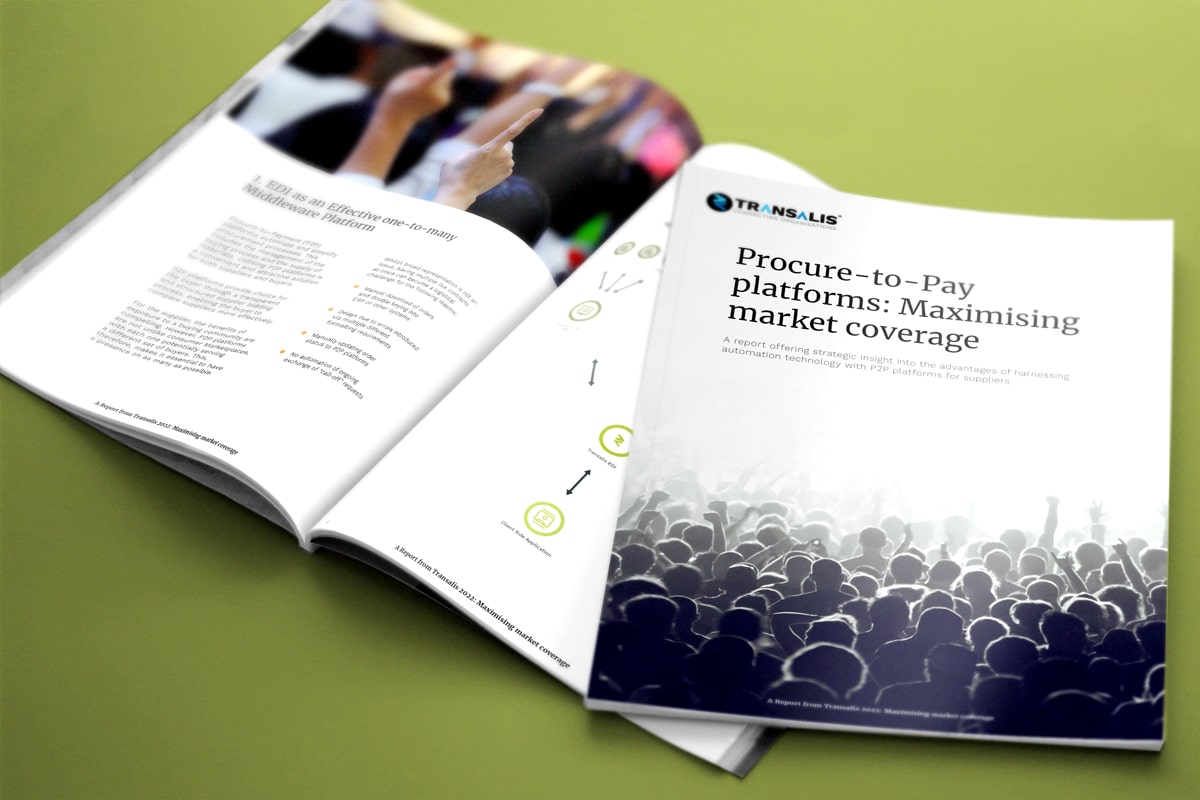
The Procure-to-Pay process can be complex, with multiple time-consuming stages and systems involved.
Procure-to-Pay (P2P) platforms help to automate the procurement cycle. For example, a P2P platform can manage the initial proposition listing, through to the tender, and order fulfilment. They can also provide brand exposure in new markets, thanks to marketplace functionality.
However, even these systems have limitations in creating efficiency for the Procurement department. The main reason is that they are run independently from an organisation’s systems. Therefore there are significant bottlenecks in the manual processing of information that must be communicated across the various platforms being used, as well as internal systems. This is why integrating business systems is recommended, not only to unburden these teams but to also support performance visibility and strategic decision-making.
In this blog, we outline the top P2P platform integrations and why they are essential in transforming the Procure-to-Pay process.
Increasing market visibility
Ensuring market reach for B2B suppliers can be tough. Our report explores how a strategic use of Procure-to-Pay platforms can help.

Digital transformation in Procurement
Procure-to-Pay platforms are attractive for both buyers and suppliers:
P2P platforms offer a structured supplier bidding process that supports transparency for buyers to accurately compare propositions.
These platforms also provide the supplier with significant exposure to buying communities across targeted industries.
Furthermore, organisations are drawn to P2P platforms because they can benefit the full procurement cycle in many ways.
Firstly, P2P platforms put the buyer at the centre of the Procure-to-Pay process. A customer-centric approach improves buyer-supplier relationships and suppliers can more readily identify market opportunities. Supporting this, P2P platform analytics enables suppliers to become more predictive than reactive. Thirdly, thanks to the digitisation of communications between the supplier and buyer the team can focus on higher-value procurement tasks, thus improving operational efficiency.
Integrating P2P platforms with internal systems enhances these benefits for suppliers. Connecting these isolated systems can result in a fully automated procurement cycle. For instance, integrating a P2P platform with an Enterprise Resource Planning (ERP) system enables businesses to automatically update inventory levels and financial records. This reduces the risk of errors and improves financial visibility. Another example could be integrating with a Customer Relationship Management (CRM) system. This improves relationship management by providing a centralised view of interactions and performance. Organisations that are managing multiple P2P platforms will benefit from a middleware integration solution. We enacted this strategy for one of our clients as detailed in our case study.
Overall, integrating a P2P platform with internal business systems helps businesses support operations, reduce costs, and improve performance.
The top P2P integrations for B2B suppliers
Now we’ve established why B2B suppliers use procurement platforms and the benefits of consolidating business systems, here is a list of the top Procure-to-Pay platforms for B2B suppliers.
Basware Public & Private Sectors
Basware is a leading P2P platform for public and private sector organisations. Thanks to its advanced catalogue management, Basware enables buyers to search and compare products and services easily across a global network of suppliers. And with over 2 million businesses registered on the platform, suppliers registered on Basware will benefit from access to a vast buyer network.
Birch Street
Birch Street is an e-procurement platform designed for the hospitality industry. Key features of the cloud-based solution include a digitised RFQ process, product catalogues with real-time pricing, and analytics. Birch Street’s buyer-network size is significant, with over 400,000 suppliers using the marketplace to access the network of hotels, restaurants, and catering businesses.
Causeway
Causeway offers cloud solutions specifically tailored to the construction industry. The supplier management features included in this solution simplifies procurement processes for buyers. The solution includes features such as eCatalogue and eBilling functionality, accreditation, performance management, as well as tendering for efficient P2P processing.
Celtrino
With Celtrino’s intuitive platform, businesses can simplify the P2P cycle. This purchase-to-pay platform supports supplier onboarding, automated purchase order processing, invoice management, and payment processing. The solution can also be integrated into ERP systems and can also facilitate PEPPOL public sector connections.
CloudBuy
CloudBuy’s eProcurement solution has been around since 2002. It supports organisations of all sizes from SMEs to large multinationals with a simple-to-use self-managed solution. This eProcurement solution brings ‘consumer-style’ shopping to B2B transactions with a hosted catalogue feature.
Coupa
Coupa offers a suite of digital procurement solutions to support purchase requisitions, centralised supplier catalogues, spend management, and fraud protection. In addition, this provider also offers customers the opportunity to combine this with other services, such as contract lifecycle management, or supplier risk management, which together support a full P2P process.
Fourth
Fourth inventory and procurement solutions are specifically built for the hospitality sector, including; pubs, restaurants, hotels, resorts, and quick service. Users have access to the Fourth platform to facilitate an automated supply chain. Buyers benefit from access to a large supplier network, and suppliers benefit from online catalogue management and analytics.
JAGGAER
JAGGAER’s offers an all-in-one procurement software platform which provides users full control and visibility of their Procure-to-Pay process. The JAGGAER ONE platform grants access to the partner network, a global alliance and channel partner program, with ‘Source-to-Pay’ functionality.
OneAdvanced
OneAdvanced provides cloud-first solutions to both public and private sector organisations. This includes the Advanced Marketplace which helps organisations find the right products from suppliers and gain complete control over their spending. Suppliers that harness OneAdvanced can access this vast network of buyers.
Paragon
Paragon’s Lead Supply solution hails the evolution of print and marketing procurement. This is underpinned by a broad supplier network. Suppliers of print & digital solutions to this sector will benefit from increased visibility with access to Paragon’s buyer network.
Proactis
Proactis offers Procurement Control Solutions to B2B buyers that require greater control and visibility of their business spend. This includes sourcing, relationship management, contract management, and marketplace functionality. Suppliers are able to access the Proactis network of buyers through the Proactis marketplace, which includes a central directory of items.
SAP Ariba
SAP Ariba is one of the largest and most popular eProcurement solutions available. The catalogue combines a customer-centred product/service marketplace with a sophisticated Procure-to-Pay process. The procurement solution also offers flexible content management tools for suppliers.
Tungsten
Tungsten offers users a centralised procurement system that is equipped with data analytics for suppliers to utilise and a growing network of over 100,000 suppliers for buyers to choose from. It ensures efficient global P2P process compliance with its eProcurement solution, to align inter-departmental processing including; Accounts Payable, Accounts Receivable, and Procurement functions.
eDI Software
Need to discuss improvements to your Procure-to-Pay process in more depth? Book a meeting with a member of our helpful team, or contact us directly via 0845 123 3746 (UK callers) or +44 1978 369 343 (international callers), or email us at sales@transalis.com. You can also explore our other resources in our Knowledge Hub, where we publish insightful blogs, quarterly reports and in-depth client case studies.











